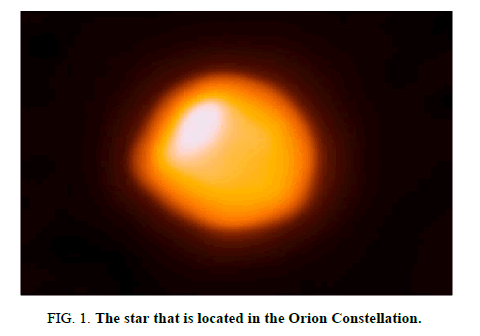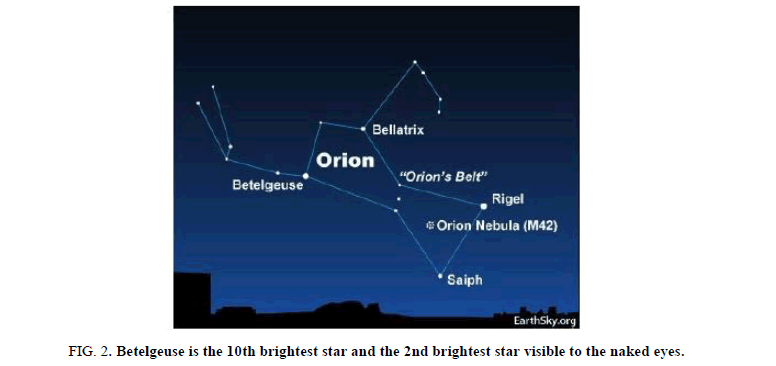Viewpoint
, Volume: 5( 4)Betelgeuse
- *Correspondence:
- Dean Bartolome Department of Astronomy, 9th Grade Science, Philippines, Tel: +972 1-800-660-660; E-mail: deanb4087@gmail.com
Received Date: October 26, 2017 Accepted Date: October 31, 2017 Published Date: Novmber 02, 2017
Citation: Dean Bartolome. Betelgeuse. J Phys Astron. 2017;5(4):124
Abstract
Betelgeuse located 430 light-years away in the Orion Constellation, Betelgeuse isthe 10th brightest star and the 2nd brightest star visible to the naked eyes. Betelgeuse is not that hard to locate. If you look up in the night sky, it should be one of the brightest star up there. The Orion Constellation is visible through January to March. During the winter, the constellation is located in the Southern Hemisphere. During the summer, in the Northern Hemisphere. The color of Betelgeuse is somber orange-red or a mix of orange and red. The temperature of the star is 6,000℉ or 3,600 K. If our Sun and Betelgeuse were next to each other, Betelgeuse would be 1,000 times brighter than our Sun. It’s luminosity is 140,000 times of the sun’s, imagine looking at that. Betelgeuse is 15 times heavier in mass than our dear Sun and is 600 times wider. With a mass of that high, the gravitational pull is very big (FIG. 1).
Betelgeuse
Betelgeuse located 430 light-years away in the Orion Constellation, Betelgeuse isthe 10th brightest star and the 2nd brightest star visible to the naked eyes. Betelgeuse is not that hard to locate. If you look up in the night sky, it should be one of the brightest star up there. The Orion Constellation is visible through January to March. During the winter, the constellation is located in the Southern Hemisphere. During the summer, in the Northern Hemisphere. The color of Betelgeuse is somber orange-red or a mix of orange and red. The temperature of the star is 6,000? or 3,600 K. If our Sun and Betelgeuse were next to each other, Betelgeuse would be 1,000 times brighter than our Sun. It’s luminosity is 140,000 times of the sun’s, imagine looking at that. Betelgeuse is 15 times heavier in mass than our dear Sun and is 600 times wider. With a mass of that high, the gravitational pull is very big (Figure 1).
Extra Facts
Betelgeuse, sadly, is about to die. It will blow up and turn into a Supernova. (Figure 2) The star has run out of fuel to keep it up-running. Luckily for us, we won't be affected by it. The star is too far away to cause harm to us. Betelgeuse does not have any planets orbiting it, as far as we know. Additionally, the position of Betelgeuse is RA 05 h 55 m 10.3053 s, dec+07° 24’25.4” [1-4].
Figure 2: Betelgeuse is the 10th brightest star and the 2nd brightest star visible to the naked eyes.
References
- [No authors listed]. Astropixels.com. astropixels.com/stars/Betelgeuse-01.html.
- [No authors listed]. “Betelgeuse Will Explode Someday.” EarthSky. earthsky.org/brightest-stars/betelgeuse-will-explode-someday.
- Writer. Calla Cofield Space.com Senior. “Dying Star Betelgeuse Keeps Its Cool and Astronomers Are Puzzled.” Space.com.
- [No authors listed]. www.space.com/31693-dying-star-betelgeuse-puzzles-astronomers.html.



